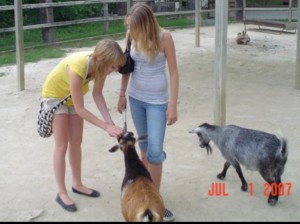FoodNet Canada (formerly known as C-EnterNet) is a preventive, multi-partner sentinel site surveillance system, facilitated by the Public Health Agency of Canada, that identifies what food and other sources are causing illness in Canada.
 Each sentinel site is founded on a unique partnership with the local public health unit, private laboratories, and water and agri-food sectors, as well as the provincial and federal institutions responsible for public health, food safety, and water safety. The pilot sentinel site (ON site), comprised of the Region of Waterloo, Ontario, has approximately 525,000 residents, with a mix of urban and rural communities and innovation in public health and water conservation.
Each sentinel site is founded on a unique partnership with the local public health unit, private laboratories, and water and agri-food sectors, as well as the provincial and federal institutions responsible for public health, food safety, and water safety. The pilot sentinel site (ON site), comprised of the Region of Waterloo, Ontario, has approximately 525,000 residents, with a mix of urban and rural communities and innovation in public health and water conservation.
A second site (BC site) was officially established in the Fraser Health Authority, British Columbia in April of 2010. This BC site includes the communities of Burnaby, Abbotsford, and Chilliwack and has approximately 450,000 residents.
In the ON site, enhanced surveillance of human cases of enteric disease in the community is performed, as well as active surveillance of enteric pathogens in water, food (retail meat and produce) and on farms. In the BC site in 2010, enhanced human disease surveillance began, as did active surveillance of enteric pathogens (for retail produce only).
The following key findings are based on the surveillance data from 2011–2012 in the ON and BC sites:
- A total of 1663 human cases of 11 bacterial, viral and parasitic diseases were reported within the ON and BC sites between 2011 and 2012. The three most frequently reported diseases (campylobacteriosis, salmonellosis and giardiasis) accounted for 82% of the cases.
- Campylobacteriosis remained the most commonly reported enteric disease in both sentinel sites, with Campylobacter jejuni being the most common species associated with human campylobacteriosis. The majority of raw chicken samples tested were also contaminated with Campylobacter jejuni. Possible exposure factors included living on a farm or country property, contacting on-farm poultry, contacting household pets, contacting animal manure and consuming spoiled food. Overall, as found in the past, retail chicken meat was considered to be the most important vehicle of transmission for Campylobacter.
Distributions of patient age and gender among the human salmonellosis cases between 2011 and 2012 were similar to those observed historically in both the ON and BC sites. The most commonly reported serovars for human cases of salmonellosis were Enteritidis, Typhimurium, and Heidelberg. Phage type alignment continues to be observed among isolates from endemic human cases, chicken meat, and broiler chicken feces for both Salmonella Heidelberg and Salmonella Enteritidis. A slight decrease was observed in the rate in both sites (in 2011–2012 combined compared to 2010), which is comparable to the national trend observed during the same time period (2, 3, 7, 8). The prevalence of Salmonella on ground chicken was twice the level found on chicken breast. This may highlight the greater chance of product contamination during processing. Overall, possible salmonellosis exposure factors included contact with pet reptiles, retail poultry products, and broiler chicken manure (Table 4.6). The most important possible vehicle of transmission is considered to be retail poultry products.
• Verotoxigenic E. coli (O157:H7 and non-O157:H7 serotypes) infections continue to be primarily acquired domestically, as demonstrated by the low number of travel-related cases in 2011–2012. E. coli O157:H7 PFGE patterns in both human and non-human samples from 2011–2012 continued to show considerable diversity, as observed nationally and within the FoodNet Canada sites, in past years.
• As in previous years, the majority of Yersinia cases are domestically acquired. Among travel-related cases, the majority reported travel to Central or South America in 2011–2012. The incidence in domestically acquired cases was much higher in females than males. None of the swine manure samples in the ON site in 2011 were positive for pathogenic Yersinia (biotype 4, serotype O:3). • As in previous years, pathogenic strains of Listeria monocytogenes were recovered in 2011–2012 from samples of skinless chicken breasts, ground beef, ground chicken and ground turkey, as well as uncooked chicken nuggets. The scientific literature suggests that abattoirs and meat processing environments rather than farm animals may be an important source of L. monocytogenes (21). The retail meat data from many historical surveillance years indicate that pathogenic serotypes of L. monocytogenes are present on raw chicken, beef, and pork meat sold at retail, as well as in bagged leafy greens. Although, based on one PFGE enzyme, there was a match between a human case and a sample of uncooked chicken nuggets in 2011–2012, there were no matches between sources and sentinel site cases of listeriosis in 2011–2012 when both PFGE enzyme patterns were compared. Also, based on one enzyme, a few matches were identified between meat isolates (chicken and beef) and four of the top five PFGE patterns reported at the national level in humans (according to PulseNet Canada data). In 2012, fresh herbs were tested for L. monocytogenes though the pathogen was not detected.
• The majority of Shigella infections were travel-related, with Asia being the most frequently reported travel destination.
FoodNet Canada surveillance identified human pathogenic strains of norovirus on retail soft berries and fresh herbs in 2011–2012. Historically, pathogenic subtypes have also been found in food animal manure, as well as retail pork chops and leafy greens.
 • Cryptosporidium was found in 2011–2012 on retail soft berries and in untreated surface water. Giardia was detected on retail soft berries and herbs, and water in the same period. Also, Cyclospora was found on soft berries. However, the viability of these pathogens was unable to be determined.
• Cryptosporidium was found in 2011–2012 on retail soft berries and in untreated surface water. Giardia was detected on retail soft berries and herbs, and water in the same period. Also, Cyclospora was found on soft berries. However, the viability of these pathogens was unable to be determined.
• Travel outside of Canada continued to add to the burden of enteric disease observed in Canada during 2011–2012, with 27% of the reported cases from both sites (combined) likely involving infections acquired abroad. Safe travel practices continue to be important considerations among Canadians.
• Enhanced, standardized laboratory testing across all FoodNet Canada surveillance components (human, retail, on-farm, and water) has allowed for the identification of patterns in subtype distributions among human cases and potential exposure sources over time. Continued surveillance and addition of more sentinel sites will help in refinement of the key findings and inform prevention and control measures for enteric diseases in Canada.











